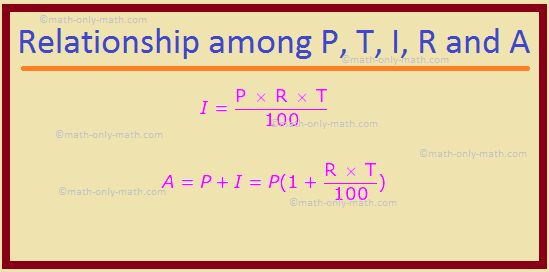Subscribe to our ▶️ YouTube channel 🔴 for the latest videos, updates, and tips.
Compound Interest Definition
We will discuss here about some of the basic terms related to compound interest.
Principal: The money lent by the lender (or received by the borrower) is the principal. It is denoted by P.
Time: The duration for which money is lent (or borrowed) is the time. It is denoted by T (or, t).
Interest: The difference of the money paid back and the money borrower is the interest. It is denoted by I.
Rate: The rate of interest is the interest paid on every $ 100 for a specific period of time, usually one year, six months, three months or one month. It is denoted by R (or, r).
Amount: The sum of the principal and the interest on it is the amount. It is denoted by A.
Simple Interest: The interest is a simple interest if the principal P remains same over the entire period for which money is borrowed (or lent).
The formulae governing the relationship among P, T, I, R and A are as follows:
\[I =\frac{\mathrm{P\, \times \, R \, \times \, T}}{100}\] and
\[A = P + I = P(1 + \frac{\mathrm{R \, \times \, T}}{100})\]
Compound Interest:
Many lenders such as banks add the simple interest payable at the end of a specified time such as one year to the principal if the period of borrowing is more than one year, and treat this cumulative amount as the new principal for the next year of borrowing. The simple interest is then calculated on the new principal for the next year of borrowing. The simple interest is then calculated on the new principal for the next year. In such a situation, the interest is called compound interest. Note that it is not necessary for the specified time to be one year. It could be six months, one-fourth of a year, and so on.
Thus, the amount with compound interest on a principal P for a period of two years
= (P + I) + I’,
When P = principal, I = simple interest for one year on P
And I’ = simple interest for one year on (P + I).
In other words,
the compound interest on a principal P for two years = (Simple interest on P for two years) + (Simple interest for one year on the simple interest on P for one year) + (Simple interest for one year on the simple interest on P for one year).
Clearly, (i) The compound interest on a principal P for two years > The simple interest on the same principal for two years.
(ii) The difference of the compound interest and the simple interest on a principal P for two years = the simple interest on the principal I for one year, where I is the simple interest on the principal P for one year.
From Compound Interest Definition to HOME PAGE
Didn't find what you were looking for? Or want to know more information about Math Only Math. Use this Google Search to find what you need.



New! Comments
Have your say about what you just read! Leave me a comment in the box below. Ask a Question or Answer a Question.